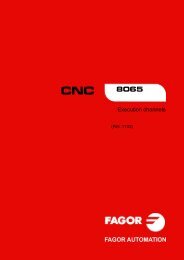4 - Fagor Automation
4 - Fagor Automation
4 - Fagor Automation
Create successful ePaper yourself
Turn your PDF publications into a flip-book with our unique Google optimized e-Paper software.
Canned cycles (·M· model)<br />
L Finishing stock.<br />
It defines the finishing stock at the bottom of the thread. If not programmed, a value of 0 is<br />
assumed.<br />
A Maximum penetration step.<br />
Defines the maximum penetrating pass of the thread. If not programmed or programmed with<br />
a 0 value, it will run a single pass up to the finishing stock.<br />
E Approach distance.<br />
Approach distance to the thread entry.<br />
C=0 C=1 C>1<br />
Q Thread entry (start) angle.<br />
Angle (in degrees) of the segment formed by the center of the hole and the thread entry point<br />
with respect to the abscissa axis. If not programmed, a value of 0 is assumed.<br />
Basic operation<br />
1 Rapid movement to the center of the hole (X, Y).<br />
2 Rapid movement to the reference plane (Z).<br />
3 Rapid movement of the plane axes to the thread entry point (it only makes this movement<br />
if parameter E has been programmed).<br />
4 Rapid movement to the thread entry point coordinate along the longitudinal axis.<br />
5 Rapid movement to the thread entry point (movement interpolated in 3 axes).<br />
6 Thread entry with a helical movement tangent to the first helical threading path.<br />
7 Making the thread according to the value of parameter C.<br />
C=0 Helical movement, in the direction indicated in parameter J, to the bottom of<br />
the thread (the movement will only be one revolution). Then, helical thread<br />
exiting movement, tangent to the previous helical path.<br />
It must be borne in mind that in the exit tangent to the helical path, the exit<br />
point will exceed the coordinate of the bottom of the thread along the<br />
longitudinal axis.<br />
C=1 Helical movement, with the pitch and direction given in parameter J, to the<br />
bottom of the thread. Then, helical thread exiting movement, tangent to the<br />
previous helical path.<br />
It must be borne in mind that in the exit tangent to the helical path, the exit<br />
point will exceed the coordinate of the bottom of the thread along the<br />
longitudinal axis.<br />
C=n Threading loop until reaching the bottom of the thread.<br />
Helical movement, with the pitch and direction given in parameter J, (the<br />
movement will be one revolution).<br />
Helical thread exiting movement, tangent to the previous helical path.<br />
Rapid movement to the Z coordinate of the thread entry point of the next<br />
threading path.<br />
It must be borne in mind that in the last helical exit, the exit point will exceed<br />
the coordinate of the bottom of the thread along the longitudinal axis.<br />
8 Rapid movement to the reference plane (G99).<br />
9 Repetition of steps 3 to 8 until reaching the depth of the finishing stock.<br />
10 Repetition of steps 3 to 8 until reaching the bottom of the thread.<br />
11 Rapid movement to the reference plane (G99) or to the starting plane (G98).<br />
1.<br />
MILLING CANNED CYCLES.<br />
G212. Outside thread milling cycle<br />
CNC 8065<br />
(REF: 1209)<br />
·63·

















